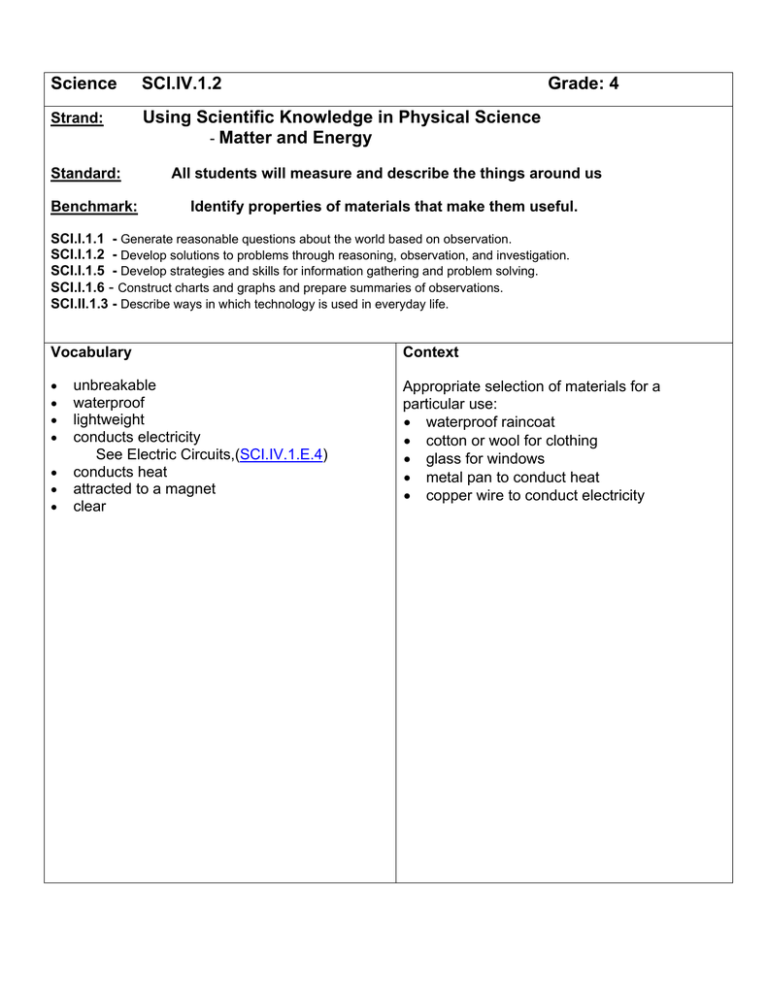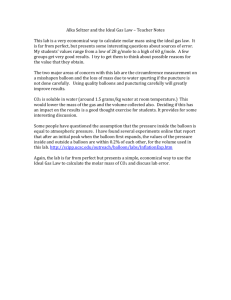Science SCI.IV.1.2 Grade: 4
advertisement

Science SCI.IV.1.2 Strand: Using Scientific Knowledge in Physical Science - Matter and Energy Standard: Benchmark: Grade: 4 All students will measure and describe the things around us Identify properties of materials that make them useful. SCI.I.1.1 - Generate reasonable questions about the world based on observation. SCI.I.1.2 - Develop solutions to problems through reasoning, observation, and investigation. SCI.I.1.5 - Develop strategies and skills for information gathering and problem solving. SCI.I.1.6 - Construct charts and graphs and prepare summaries of observations. SCI.II.1.3 - Describe ways in which technology is used in everyday life. Vocabulary Context • • • • Appropriate selection of materials for a particular use: • waterproof raincoat • cotton or wool for clothing • glass for windows • metal pan to conduct heat • copper wire to conduct electricity • • • unbreakable waterproof lightweight conducts electricity See Electric Circuits,(SCI.IV.1.E.4) conducts heat attracted to a magnet clear Knowledge and Skills Benchmark Clarification: Some properties make materials useful in the real world and require tools to observe: • magnetism • conductivity See Electric Circuits, (SCI.IV.1.E.4). • buoyancy • flexibility • hardness • transparency See Uses of Earth Materials, (SCI.V.1.E.5). Other attributes require tools, measurements and calculations: • length • weight • density Students will: Investigate and identify properties of materials that make them useful in the real world. • Resources Coloma Resources: Scott Foresman Discover the Wonder Module B Chpt 2 Curious Kids Museum – “Rocks and Minerals” Other Resources: Teacher’s Domain – Video clip and activity Balloon Brain: Designing a Helmet http://www.teachersdomain.org/K2/sci/phys/descwrld/zhelmet/index.html Teacher’s Domain – Video clip and activity Balloon Brain: Designing a Helmet http://www.teachersdomain.org/K2/sci/phys/descwrld/zhelmet/index.html • Justify the reason(s) for their selection of materials based on the properties (e.g., what materials would you use to construct a backpack and why?) o canvas (durable) o plastic (waterproof) Teacher’s Domain - Density and Buoyancy: Experimenting with Club Sodavideo segment and activity - gas-filled bubbles act like life jackets for raisins, making them buoyant. • Explain their reasoning to another person http://www.teachersdomain.org/K2/sci/phys/descwrld/zsoda/index.html Hewitt, Sally. Solid, Liquid or Gas? Usbourne, 1998. Assessment Instruction Focus Question: What materials would you use to construct a familiar object (e.g., backpack, model airplane, helmet)? Students will compare, analyze, and discuss useful characteristics of different materials to make a helmet for a water balloon (or egg). Optional Assessment: Student discussion and participation Student evaluation of helmet design – indicating understanding. (See Instruction Section) Give students rubric before activity.) Students will work with partners to select and construct a helmet for a water balloon (or egg). They will: • Discuss the characteristics of a helmet. • Collect a variety of materials from which to make a helmet and will classify them by useful characteristics • Design and construct a helmet for their balloon (egg) using appropriate materials. • Test the effectiveness of their helmet (outside). • Evaluate the materials used to construct a helmet and record their evaluations in their science journals. • Watch the ZOOM video clip on designing balloon helmets and see how they compare. Materials: per group of 2 students: 1 filled water balloon or egg (depending on preference of teacher) tissue paper newspaper bubble wrap egg cartons – cardboard and styrofoam fabric (any other material that can be shaped into a covering) tape string glue (?) ladder from which to drop balloons (eggs) Be sure to show students the ZOOM video clip on balloon helmets: Teacher’s Domain – Video clip and activity - Balloon Brain: Designing a Helmet http://www.teachersdomain.org/K2/sci/phys/descwrld/zhelmet/index.html Scoring Rubric Criteria: Evaluation of helmet Apprentice - Describes one useful property of the helmet Basic - Describes two useful properties of the helmet. Meets - Describes three useful properties of the helmet. Exceeds - Describes four or more useful properties and suggests another. Criteria: Efficiency of Design Apprentice - Egg/Balloon broke before it was dropped from the ladder Basic - Egg/balloon broke on impact. Meets - Egg/balloon survived the 1st fall. Exceeds - Egg/balloon survived multiple falls. Teacher Notes: http://www.misd.net/mibig/ Measure and describe the things around us. Elementary school children should be able to describe attributes of matter, which are qualitative, such as color, smell, size, and texture. Other attributes of matter are magnetic properties, such as attract and repel and density determined by sinking and floating. As students get more experience with qualitative aspects, they can move to quantitative attributes such as mass, weight, volume, and length. Students often have difficulty understanding the concept of matter. Research suggests that children often think that everything that exists is matter, including heat, light and electricity. They may also think that matter does not include liquids and gases. Mass and weight are two different ways to measure matter. Mass is a measure of the amount of matter in an object and a measure of the amount of inertia an object has. Mass does not change. Weight is dependent on location and can vary depending on where it is measured. Weight will be less if you are on the moon compared to the earth. Some students are confused about the difference between mass and weight. Mass is a property of all matter, weight depends on gravity. If there is no gravity, there can be no weight. Accepting weight as an intrinsic property of matter is difficult for some students. It is interesting to note that many sixth and seventh grade students still appear to think of weight as "felt weight". This leads them to think that if they cannot feel the weight then matter has no weight at all. Volume is another way to measure matter. Volume measures the amount of space an object occupies. Two objects can have the same mass, but very different volumes. Students frequently confuse mass and volume thinking that they describe the "amount of matter" and therefore are the same. Elementary students are often asked to identify floating and sinking objects. This poses problems for elementary students who misunderstand why objects sink or float. Density and buoyancy are complex ideas for students and are difficult to understand and teach at the elementary level. It is important to know that some students will think that objects sink in water because they are heavier than water. They also may think that objects float because they have air in them. In order to really understand floating and sinking, students must understand density. Objects sink if they are denser than the liquid and float if they are less dense than the liquid. Freighters are an excellent example of sinking and floating to begin to challenge students' ideas. Freighters are huge steel ships that are very heavy. Just the paint used to protect them can weigh tons. Yet large ships float because they displace their weight in water. Density is a ratio of mass to volume and is, therefore, a derived quantity. Density is a property of matter that does not change, regardless of the size of the sample. However, the density of an object can be altered by increasing or decreasing the volume of the object, while keeping the mass constant. For example, a hot air balloon rises when the air inside the balloon is heated because the process of heating causes the volume of air inside the balloon to increase and the density to decrease. Interestingly, students often confuse density and thickness, assuming that thick liquid is denser than thinner, less viscous liquids. Simple experiences with everyday objects can make it clear that this is not true. Oil is much thicker, more viscous, than water and yet is less dense than water. The thickness of a liquid is related to the strength of the intermolecular forces rather than spacing between molecules Measurement is an important skill that students begin developing in the earliest years. It begins with non-standard units of length, volume, and mass. An important concept is that any measurement is an estimation to the nearest unit being used. The measurement tool and the unit will be determined by the attribute being measured and the purpose of the measurement. Students must be able to select and use a balance to measure mass and measuring cups or graduated cylinders for volume. When measuring matter, students should understand that all measurements have error because one must always estimate the last reported digit. When measuring, a person must estimate one more place than the last number on the measuring device. All instruments have limitations on their ability to measure. Importantly, students in the middle school should be able to explain and use appropriate measurements to describe the properties of an object or substance. For example, they need to be able to determine if they should use mass or weight when finding density and they need to know when to use area and volume. Beginning in the elementary years, students should be able to identify the properties of materials that make them useful. This can be tied to simple ideas like strength or stretching and to more complex ideas like the conduction of heat and electricity. In the high school years, students are asked to analyze properties of common household and agricultural materials for risks and benefits.







